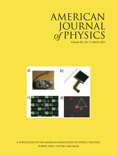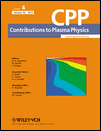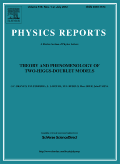
Nuovo Cimento C-Colloquia and Communications in Physics
Scope & Guideline
Fostering Dialogue in Physics and Astronomy
Introduction
Aims and Scopes
- Physics Education and Pedagogy:
The journal emphasizes innovative teaching strategies and methodologies in physics education, focusing on improving curricula and instructional methods in secondary and higher education. - Experimental Physics and Techniques:
It covers a wide range of experimental techniques and methods used in physics research, including advancements in detector technology, calibration methods, and measurement techniques relevant to various fields of physics. - Interdisciplinary Research:
The journal promotes interdisciplinary studies that connect physics with other scientific fields, such as biology, environmental science, and engineering, fostering a holistic understanding of scientific phenomena. - Theoretical Physics and Computational Models:
It includes contributions related to theoretical advancements in physics, such as quantum mechanics, statistical mechanics, and computational modeling that provide insights into complex physical systems. - Applied Physics and Technology:
The journal also addresses practical applications of physics research in technology and industry, including developments in materials science, nanotechnology, and medical physics.
Trending and Emerging
- Innovative Teaching Strategies:
There is an increasing focus on innovative instructional methodologies in physics education, such as inquiry-based learning, project-based learning, and the integration of technology in the classroom to enhance student engagement and understanding. - Interdisciplinary Approaches:
Research that combines physics with other disciplines, particularly in areas such as environmental science, health physics, and computational modeling, is gaining traction, highlighting the importance of interdisciplinary collaboration in solving complex scientific problems. - Advancements in Detector Technology:
A growing number of publications are dedicated to advancements in detector technologies and methodologies, particularly in high-energy physics, medical physics, and materials science, reflecting the ongoing evolution of experimental techniques. - Applications of Machine Learning in Physics:
The application of machine learning and data analysis techniques in physics research is emerging as a significant trend, with many studies focusing on utilizing AI to enhance data processing, improve experimental design, and analyze complex datasets. - Climate Change and Environmental Physics:
There is a noticeable increase in research related to climate change and its physical underpinnings, as well as the role of physics in understanding and addressing environmental challenges, reflecting a broader societal concern.
Declining or Waning
- Traditional Physics Education Methods:
There has been a noticeable decline in the publication of papers focused on traditional teaching methods, such as rote learning and lecture-based instruction, as the field moves towards more interactive and student-centered approaches. - Basic Experimental Techniques:
Research papers detailing basic experimental methods and techniques that were once prevalent are becoming less frequent, as the focus shifts towards more advanced and innovative methodologies. - Purely Theoretical Physics:
While theoretical contributions remain important, there is a reduced emphasis on purely theoretical papers that do not connect to experimental results or practical applications, reflecting a growing trend towards applied research.
Similar Journals

INDIAN JOURNAL OF PHYSICS
Fostering Knowledge Exchange in the World of PhysicsINDIAN JOURNAL OF PHYSICS, published by the Indian Association for Cultivation of Science, serves as a pivotal platform for researchers and scholars in the field of physics and astronomy. With its ISSN 0973-1458 and E-ISSN 0974-9845, this journal is committed to presenting innovative research and developments across diverse topics in physics, covering both theoretical and experimental studies. The journal has made its mark in the academic community, evidenced by its classification in the Q3 category within the Physics and Astronomy domain as of 2023, and ranks #100 out of 243 in the Scopus curated database, placing it in the 59th percentile. Spanning from 2005 to 2024, the INDIAN JOURNAL OF PHYSICS aims to foster knowledge exchange and stimulate discussions among physicists and scientific enthusiasts. Whether you are a researcher looking to publish your findings, a professional seeking updates in your field, or a student eager to explore varying aspects of physics, this journal is an invaluable resource contributing significantly to the understanding and advancement of physics in India and beyond.

TECHNICAL PHYSICS
Exploring Innovations in Theoretical and Applied PhysicsTECHNICAL PHYSICS, published by PLEIADES PUBLISHING INC, is a prestigious journal that has been serving the scientific community since its inception in 1996. With a focus on the diverse realms of physics and astronomy, this journal is committed to publishing pioneering research that spans various aspects of theoretical and applied physics. Though currently categorized in the Q3 quartile for the year 2023, TECHNICAL PHYSICS holds considerable merit with a Scopus ranking of #56 out of 81 in its field, positioning it within the 31st percentile. The journal aims to provide a platform for researchers, professionals, and students to disseminate their findings and foster collaboration within the global physics community. While it does not currently offer open access, the journal remains a vital resource for those seeking to stay informed of the latest advancements and trends in technical physics. Based in the heart of New York, it continues to contribute to the evolution of this dynamic field.

INTERNATIONAL JOURNAL OF MODERN PHYSICS A
Exploring the cosmos and the building blocks of matter.INTERNATIONAL JOURNAL OF MODERN PHYSICS A, published by WORLD SCIENTIFIC PUBL CO PTE LTD, stands as a pivotal platform in advancing the frontiers of research within the fields of Astronomy and Astrophysics, Atomic and Molecular Physics, and Nuclear and High Energy Physics. Established in 1989, this journal has systematically contributed to the scientific community, with a demonstrated impact as indicated by its Q2 category rankings across these critical disciplines in 2023. Researchers and professionals are encouraged to engage with its rigorous peer-reviewed content, fostering a deeper understanding of modern physics theories and experimental breakthroughs. Although the journal operates under a conventional access model, it remains a vital resource for those seeking to disseminate their findings and stay abreast of cutting-edge developments. With an emphasis on quality and breadth of research, the journal continues to attract submissions from leading physicists and scholars, enhancing its reputation as a key academic resource.

Romanian Journal of Physics
Connecting researchers with groundbreaking findings.Welcome to the Romanian Journal of Physics, a distinguished platform dedicated to advancing the field of physics and astronomy since its inception. Published by EDITURA ACAD ROMANE, this journal plays a pivotal role in disseminating high-quality research from Romania and around the globe, with an impressive impact factor that reflects its rigorous academic standards. With a focus on a broad range of topics in general physics and astronomy, it proudly maintains a Q2 ranking in its category for 2023, positioning itself among the top journals in the field. The journal, which has been converging valuable research contributions from 2008 until 2024, is accessible to a wide audience of researchers, professionals, and students interested in the latest developments and discoveries in physics. While it operates under a traditional publication model without Open Access, its commitment to quality research ensures that the contributions featured in its pages resonate well within the scientific community. We invite you to explore the rich findings published in the Romanian Journal of Physics and to engage with the vital discussions shaping the future of physics.

ACTA PHYSICA POLONICA B
Elevating Research in Physics and AstronomyACTA PHYSICA POLONICA B is a distinguished journal published by Jagiellonian University Press, based in Poland. This peer-reviewed publication focuses on advancing the field of Physics and Astronomy with a mission to disseminate high-quality research that spans various subfields and interdisciplinary connections. Since its inception in 1980, the journal has steadily become a reliable source of scientific discourse, continuing its commitment through 2024. With a Q3 rank in the Physics and Astronomy category, it stands as an important resource for both established and budding researchers, contributing to a deeper understanding of complex physical phenomena. The journal is indexed by Scopus, ensuring a broad reach within the academic community, although it is not classified as an open-access resource. By promoting rigorous scientific inquiry and fostering connections within the global academic landscape, ACTA PHYSICA POLONICA B plays a vital role in shaping the future of physics research.

AMERICAN JOURNAL OF PHYSICS
Fostering Understanding of Fundamental Physics Principles.The American Journal of Physics (ISSN: 0002-9505, E-ISSN: 1943-2909), published by AIP Publishing, has been a cornerstone in the realm of physics education and research since its inception. With a broad scope that covers a plethora of topics in physics and astronomy, this journal serves as a vital resource for researchers, educators, and students alike, aiming to foster a deeper understanding of the fundamental principles of physics. As of 2023, it holds a commendable Q2 ranking in Physics and Astronomy (miscellaneous), reflecting its impactful contributions and rigorous peer-review process. Although the journal does not offer open access, it continues to be widely circulated, ensuring that groundbreaking research is accessible to a dedicated audience. The convergence of historical insights and contemporary advancements makes the American Journal of Physics an essential publication for those striving to stay at the forefront of the field.

CONTRIBUTIONS TO PLASMA PHYSICS
Unveiling the Dynamics of Plasma PhysicsCONTRIBUTIONS TO PLASMA PHYSICS is a distinguished journal dedicated to advancing the field of plasma physics, published by WILEY-V C H VERLAG GMBH. Since its inception in 1988, this journal has provided a platform for high-quality research, fostering collaboration and dissemination of knowledge in the condensed matter physics domain. With its current ranking of Q3 in the 2023 assessments, the journal is recognized for its contributions to the discipline, as indicated by its position in the Scopus rankings (Rank #252/434) and 42nd percentile within its category. Researchers and professionals engaged in plasma physics are encouraged to submit their work, as the journal aims to publish innovative studies that push the boundaries of current understanding and application in plasma phenomena. While currently not offering open access, the journal remains a vital resource for insights into the complexities and advancements in plasma research, operating from its base in Germany.

Revista Cubana de Fisica
Bridging Theory and Practice in the World of PhysicsRevista Cubana de Fisica is a prominent open-access journal based in Cuba, published by EDICIONES CUBANAS. With its ISSN 0253-9268 and E-ISSN 2224-7939, this journal has been dedicated to advancing the field of Physics and Astronomy since its transition to open access in 2005, making high-quality research readily available to a global audience. Despite its current Scopus rank of #229 out of 243 in the genre, placing it in the 5th percentile, the journal remains a vital platform for disseminating innovative studies and findings, particularly within the broader scientific community in Latin America. Covering a diverse range of topics in physics, the magazine aspires to foster collaboration among researchers, students, and professionals alike, thus bridging the gap between theoretical exploration and practical application. The journal operates under the ambitious objective of contributing to the advancement of scientific knowledge from 2011 to 2024 and beyond, reinforcing its commitment to addressing contemporary challenges in physics and fostering a vibrant academic culture.

REVISTA MEXICANA DE FISICA
Connecting Emerging Scholars with Established Research in PhysicsREVISTA MEXICANA DE FISICA is a prominent academic journal dedicated to advancing knowledge in the fields of Physics and Education. Published by the SOC MEXICANA FISICA, this journal plays a pivotal role in disseminating innovative research and educational methodologies from Mexico and beyond. With a publication history that spans from 1991 to 2024, it has established itself as an essential resource for researchers, professionals, and students who seek to deepen their understanding of general physics and astronomy. The journal is classified in the Q3 quartile in both education and physics & astronomy, showcasing its quality and relevance within the academic landscape. While the journal currently operates on a subscription basis, it provides a valuable platform for emerging voices and established scholars alike. By fostering a collaborative environment for scientific discourse, REVISTA MEXICANA DE FISICA continues to be an important channel for the ongoing evolution of scientific education and exploration in the physical sciences.

PHYSICS REPORTS-REVIEW SECTION OF PHYSICS LETTERS
Unveiling the depths of scientific inquiry.Physics Reports - Review Section of Physics Letters is a prestigious journal published by Elsevier, dedicated to providing comprehensive and insightful reviews in the field of physics and astronomy. With its ISSN 0370-1573 and E-ISSN 1873-6270, this esteemed publication features high-quality content that spans a converged timeline from 1971 to 2024. Recognized as a Q1 journal in the Physics and Astronomy category for 2023, it holds a remarkable Scopus ranking of #2 out of 243, placing it firmly in the top 1% of its field. The journal serves as a pivotal resource for researchers, professionals, and students alike, facilitating the dissemination of critical analyses and contemporary developments in physics. While it is not open access, its rigorous peer-reviewed articles ensure that students and researchers remain at the forefront of scientific inquiry. With its impactful contributions, Physics Reports continues to enhance the knowledge base and push forward the boundaries of physics research.